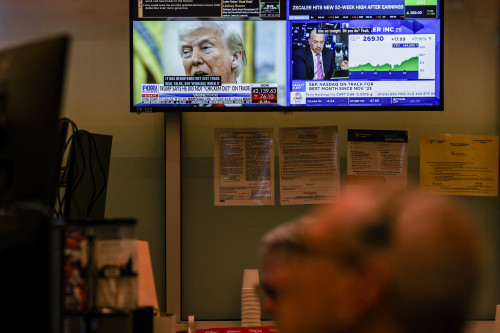By Arpan Varghese and Shashwat Chauhan
(Reuters) -Companies across the corporate spectrum revealed more pain from the cost of U.S. President Donald Trump’s tariff war, with bellwethers Caterpillar, Marriott and others on Tuesday noting weaker demand and higher prices.
All told, global companies that have reported earnings this quarter are looking at a hit of around $15 billion to profits in 2025, Reuters’ global tariff tracker shows.
A majority of these come from industrial, manufacturing and automotive sectors, while financial and tech sectors are less affected.
Trump has said the tariffs are necessary to resolve U.S. trade imbalances and declining manufacturing power; he has said the levies on imports will bring jobs and investment to the United States.
“I think we’re just getting started,” said Steve Sosnick, chief market analyst at Interactive Brokers in Greenwich, Connecticut. “The tariffs are still in their infancy, especially with major trading partners like Canada, China and India still in flux.”
Tuesday’s round of earnings illustrates the different ways trade policy is affecting companies, from the rising costs of imported materials like metals to the slippage in consumer confidence that has sapped demand.
Caterpillar, for instance, saw a 0.7% hit to revenue, while its cost of goods rose by 6.5%, and CEO Joe Creed told investors that tariffs are “likely to be a more significant headwind to profitability in the second half of 2025.”
Beer maker Molson Coors said it was expecting costs of between $20 million and $35 million in the second half of the year due to a tariff-driven rise in the price of aluminum delivered to the U.S. Midwest.
Tariffs on aluminum shipped into the United States were doubled to 50% in June from the previous 25% duty imposed in March.
MARKET RESILIENCE
The markets, however, have remained resilient even as Trump’s policies continue to change. He said on Tuesday that he would raise tariffs on goods imported from India from the current 25% as part of an ongoing spat with the country over its purchases of oil from Russia.
U.S. equities rebounded sharply from their April lows following what Trump deemed “Liberation Day,” when he unleashed a wave of global tariffs.
The S&P 500 hit all-time highs last month on the back of strong earnings, led by the so-called Magnificent Seven, a group of tech companies that have benefited from surging investment in artificial intelligence.
Of the 370 companies in the S&P 500 that have reported earnings so far, 80.3% have reported quarterly earnings above analyst estimates, with their earnings growth rate at 11.9%, according to LSEG data.
“We are figuring out that some industries may be affected, but they also might gain because (new) markets are open to them that may have been closed in the past. We’re going to have to have a couple more quarters to see how this actually plays out,” said Kim Forrest, chief investment officer at Bokeh Capital Partners.
Several market strategists of late have warned that a correction could be in the offing, but are broadly optimistic about the market. Evercore ISI analysts believe the market could dip between 7% and 15% in the September-October period as growth slows and inflation increases, though the AI-driven bull rally should continue.
Higher ingredient costs ate into profits of Taco Bell parent Yum Brands, which, like McDonald’s and other fast-food chains, leaned on budget-friendly meal deals to boost demand as U.S. consumers pull back on eating out due to worries about rising costs.
Hotel operator Marriott International cut its 2025 forecast on softening travel demand, while agribusiness giant Archer-Daniels Midland posted its lowest profit in five years.
While some market participants noted that tariff-led uncertainty was likely to persist this year, with over 100 global companies withdrawing or cutting financial guidance, others said in the longer run, companies and investors would be able to see some green shoots.
“It seems that companies themselves are a little more optimistic about the outlook now that the Liberation Day tariffs are in the rearview mirror,” said Ross Mayfield, investment strategy analyst at Baird.
“Companies are going to have to be really deft in how they navigate this (tariffs), but obviously there’s no choice but to pass some of this on to the consumer. We see S&P margins hovering around record highs, and it wouldn’t surprise me if that ticked down a little bit in the coming quarters.”
(Reporting by Arpan Varghese, Shashwat Chauhan, Nikhil Sharma and Johann M Cherian in Bengaluru; Editing by Anil D’Silva)

